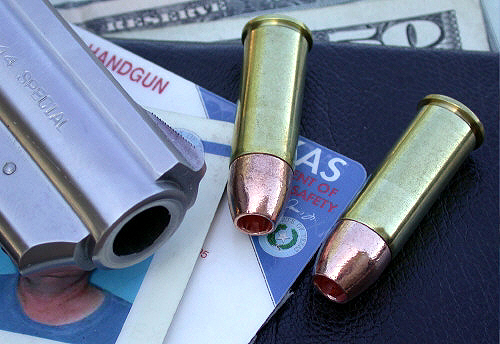
Corbon .44 Special 200-gr. DPX
Introduced in 1908, the .44 Special tossed a 246-gr. LRN just under 800 ft/sec. Though popular with many handloaders through the decades, it is a safe bet that this one just never achieved the popularity of either the .38 Special or the magnum it spawned. The .44 Magnum is undoubtedly more popular than its papa, the Special. The latter attains velocities simply not possible in guns built to handle no more than the Special's 15000 PSI working pressure.

With concealed handgun laws allowing more honest people to legally balance the playing field against felonious predators, some have opted to cast their lot with the .44 Special revolver, either as a primary weapon or backup.
In more recent times, we see that more and more states allowing honest private citizens to lawfully carry concealed handguns via various state-sanctioned licensing programs. To be sure, the semiautomatic pistol seems more popular in this role, but there is still a contingent of revolver fans. It's probably no surprise that the more popular choices remain .357 Magnum and .38 Special, usually in the +P version.

Here we see two DPX loads from Corbon. On the left is their 200-gr. DPX, which we will be focusing on in this article. Next to it is their 125-gr. .357 DPX. Some folks have more faith in heavier calibers and simply trust a defense round that begins with a "4" more than anything smaller.
As any .44 Special fancier can attest, the choice of suitable high-performance ammunition is somewhat lacking. For years, we've had Winchester's Silvertip and CCI/Speer offers a specially tweaked 200-gr. Gold Dot Hollow Point. Corbon, Triton, and others offered some relief for .44 fans, but the smorgasbord of choices has remained bleak compared to 9mm, .40 S&W, .45 ACP and more popular calibers.
The .44 Special has long been a favorite cartridge, but I've probably fired 20 reloaded shells for every factory round, if not more! Among shooters, I suspect that this is not at all uncommon. Most of my shooting is with my S&W Model 24 with a 6 1/2" barrel. The only other .44 Special I own is a Taurus Model 431. This is a fixed sight, 5-shot, DA/SA revolver and has a 3" tube. Since it is more in line with what a defense-oriented individual would be carrying, it was chosen to test Corbon's new DPX load.
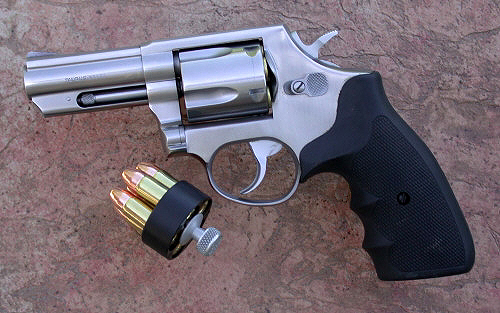
The Taurus Model 431 is this company's "K-frame" and their platform for the 5-shot .44 Special. This one has rubber grips by Michael's of Oregon and I found them a distinct improvement over the factory stocks. Not nearly so pleasing to my eye as the S&W 3" Model 65 LadySmith, the gun's weight and handling characteristics are quite similar although the DA trigger-pull is not as smooth nor the front sight as easy to see. Still, it is representative of a defensive .44 Special revolver and was used for this report.
The latest line of defensive ammunition introduced by Corbon is DPX. This acronym stands for Deep Penetrating X-bullet. Not the "magic bullet" that we're counseled not to seek, it is a bullet with outstanding features and one long-familiar with Barne's X-bullets in rifle calibers. I've seen enough of these used on big game to know that X-bullet rifle fodder is very effective. In handgun trim, the X-bullet expands via six "petals" rather than the four in rifle bullets.
X-bullets contain zero lead. There is no jacket. The bullet is a homogeneous copper alloy with a large hollow cavity and through methods unknown to me, pre-stressed to form six firm (and sharp edged) petals when impacting "soft targets."
The thing that keeps reverberating amongst those who've used the Corbon DPX in gelatin, water, wetpack, or other tissue substitutes is uniformity and reliable expansion. This is true whether impacting bare gelatin or gelatin covered with four layers of denim or other barriers designed to impede expansion. Mike Shovel of Corbon advises that the DPX line is not necessarily pushed to as high of velocity as safely possible. Instead the velocity is determined and set at the bullet's optimum performance in 10% ballistic gelatin. If the bullet reliably expands and penetrates to at least the FBI's 12" minimum at a certain speed, increasing it only achieves deeper penetration. Unlike Corbon's line of hunting bullets, the attempt with DPX has been to offer expansion and adequate penetration, but not excessive penetration, something that worries some users in possibly crowded scenarios. If one compares the velocities of Corbon's JHP's in the same weight as their DPX counterparts, the former will be higher. Cranking up the speed on a DPX bullet would probably just insure a through-and-through wound on an aggressor. These bullets do not seek to turn themselves inside out, as do more conventional aggressively expanding hollow points.
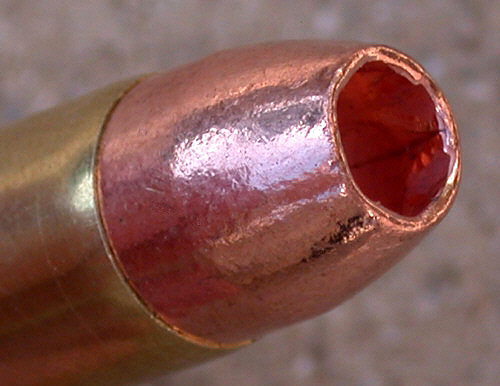
Here is the 200-gr. Corbon .44 Special DPX bullet. The hollow cavity on this one measured approximately 0.253" deep x 0.214" wide. The bullet is firmly seated in the Winchester case and has a cannulure to insure that the bullet doesn't unseat itself from the case in recoil. This did not prove to be a problem.
I sought to check this .44 Special load for accuracy, reliability, and expansion qualities. I do not have the facilities or pocketbook necessary to use 10% ballistic gelatin so I tested for expansion using "wetpack," which is simply super-saturated newsprint. My own protocol is to soak it 24 hours and let it drain 30 minutes before shooting. I then shoot plastic containers of water and compare the results. I make no claims that either perfectly represents either human or animal tissue and the "permanent cavities" associated with wetpack are larger than would be found in living tissue; the latter will collapse. (That said, it has been more than a little interesting to measure the bloodshot areas on larger animals I've shot with the measured wound tracts in the soaked newsprint. Some of the better bullets I've used in a few calibers have been nearly identical twins when removed from animals, wetpack, or water.) I use both soaked newsprint and water because I want to see how bullets perform in both. Some have expanded nicely in one, but not the other. The ones that seem to be better performers have done well in both and seem to be winners with the folks using gelatin, too.
A defensive cartridge that won't fire or one that sticks in the cylinder is a liability rather than an asset in a gun being used to potentially defend its user's life. I also paid particular attention to such things as ease of extraction, flatten primers, and tried to make bullets unseat themselves and will give the results in the conclusion.
I also wanted to see if the Corbon .44 Special DPX would "shoot." In other words, will it group at least to the requirements envisioned in most defense scenarios. I have no use for ammunition that is unstable in flight or simply inconsistent.
With these factors in mind, let's take a look what was done and the results.
Shooting: This was done at 7, 15, and 25 yards. At 7 yards, I fired double-action without support to see if the gun shifted enough in recoil to make this difficult. At 15 and 25 yards, I fired from a seated position with my wrists braced and in single-action. (I also painted that damned silver front sight blade black with a "Sharpie" so I could see it more clearly.)
With heavier, slower bullets, my Taurus Model 431's sights seem regulated for a 6 o'clock hold or least a bit below the center of the bullseye. A few practice shots indicated that for POA to coincide with POI, a more "dead on" sight picture was required out to 15 yards, but a slightly lower POA at 25 yards. I did not shoot farther today.
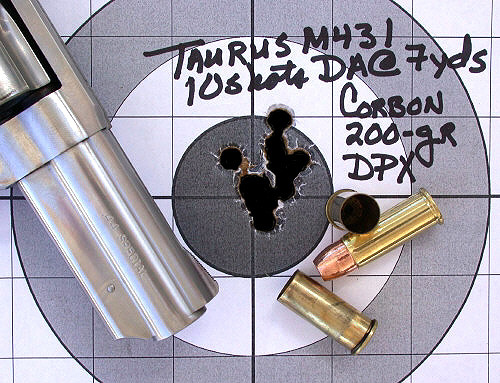

10 shots were fired at each distance. The 7-yard target was fired double-action, but the 15-yard one was shot in slow-fire and single-action from a rest. The picture on the right is getting ahead of the game here, but shows an expanded 200-gr. DPX bullet.
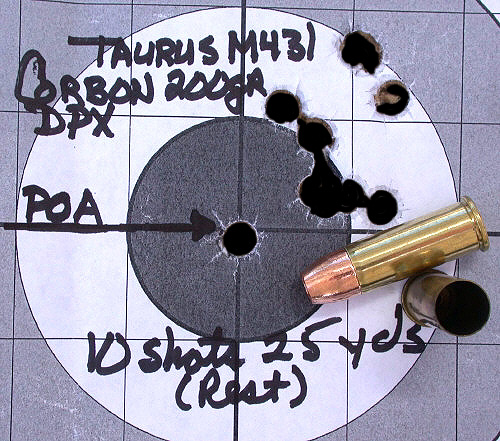
At 25 yards, a slightly lower POA would have put the bullets more closely in the bullseye. The one "pin wheel" hit is actually just one I pulled from the main group and occurred on the third shot. Not envisioned for use at these distances, it is comforting to know that if I miss, it is not because the ammunition is unstable or inaccurate.
Chronograph Results: I fired 10 shots from the Model 431 with the revolver's muzzle 10' from the chronograph screens.
Here are the velocities for each of those shots in ft/sec: 1006, 1012, 1027, 1046, 1034, 987, 1019, 998, 998, and 1004.
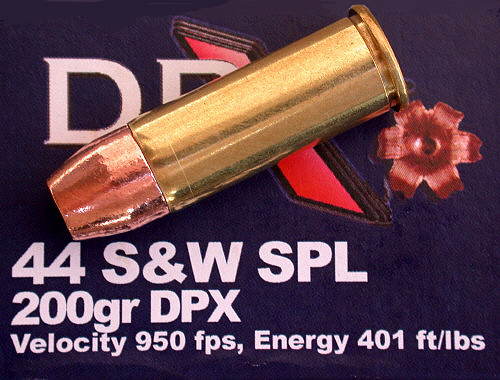
The nominal listed velocity for this cartridge can be seen on the box and is from using a 4" revolver. My gun's low velocity exceeded the listed from a 3" barrel! Though not always, I have found that Corbon's ammo frequently exceeds the round's listed speed.
This string of fire yielded:
Low Velocity: 987 ft/sec
High Velocity: 1046
Extreme Spread: 59
Standard Deviation: 18
Expansion Results: I fired one round of the .44 Special DPX into water and then 10 into wetpack to compare results. (The reason I didn't fire more into water is that it would have required more containers than I had available.)
Cutting to the chase, results were very uniform.
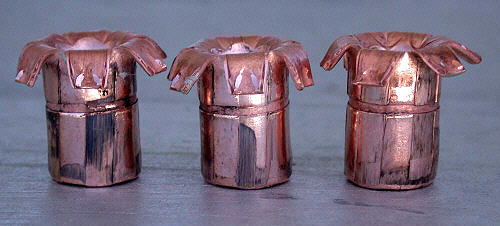
The bullets on the left and center were fired into wetpack. The DPX on the right was fired into water.
The average dimensions of the ten DPX bullets fired into wetpack were 0.718 x 0.722 x 0.655" tall.
The dimensions on the one recovered from water were 0.719 x 0.710 x 0.656" tall. None lost any measurable bullet weight.
The 200-gr. DPX bullets' penetration depths were measured and averaged. In wetpack, the DPX penetrated an average of 8 1/2". Out of curiosity, I compared the DPX' average penetration depth against the limited .44 Special ammunition I had at hand. I have performed similar "tests" on the other bullets in the past, but only fired one round into wetpack this time, as I pretty well knew what the results would be.
.44 Special Penetration from 3" Taurus M431
|
Load & Average Velocity in ft/sec: |
Penetration (in.): |
|
Corbon 200-gr. DPX, 1013 |
8.5 |
|
(Discontinued) Corbon 180-gr. XTP factory load, 1021 |
11 1/2 |
|
Handloaded 200-gr. Speer Gold Dot, 933 |
6.5 |
|
Handloaded 240-gr. Rainier Funnel Point, 864 |
8 |
|
Glaser Silver 135-gr. "Safety Slug", 1032 |
4 1/2 |
Wetpack will stop bullet penetration quicker than 10% calibrated ballistic gelatin and the results for the non-DPX loads were in line with previous results.
Here is what they did in the super-saturated newsprint.
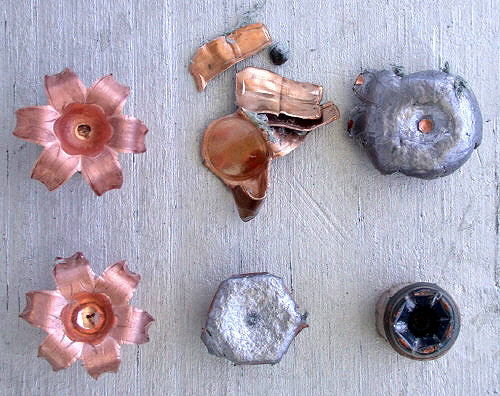
Here are expanded 44-caliber bullets recovered from the wetpack. I included two DPX bullets to show their consistency. Top row (left to right): Corbon 200-gr. DPX, Glaser 135-gr. Safety Slug (jacket and one pellet), and a handloaded Speer 200-gr. Gold Dot. Bottom Row: Corbon DPX, Corbon 180-gr. XTP, and handloaded Rainier Funnel Hollow Point. (The Rainier was moly-coated. These plated bullets are normally the usual yellowish-orange color.) The Gold Dot's expanded diameter is very similar to the DPX and it usually looses very little weight from expansion. The XTP usually doesn't expand as aggressively as some other brands of hollow points, but penetrates deeper. The Glaser had pellets strewn through the length of its "wound channel" but I only dug out one to show its size. Not the entire jacket was recovered as some fragmented into very small pieces.
The Speer Gold Dot as loaded by Speer in their Blazer line averages 829 ft/sec from my 3" Taurus. Expansion was usually pretty good in wetpack, but sometimes not at all in water, which is why I handload it faster than factory. This bullet is for speeds below 1100 ft/sec. I kept it below that out of concern for the rather thin forcing cone walls on the Taurus. The Rainier didn't expand…and wasn't expected to do so based on past experiences with it at its average velocity.
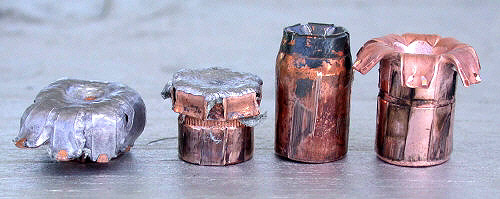
Another view of the hollow points fired (left to right): Speer 200-gr. Gold Dot handload, discontinued Corbon 180-gr. XTP, handloaded Rainier 240-gr. Funnel Point, and Corbon 200-gr. DPX.
Conclusion: Corbon's .44 Special DPX looks like a winner to me. It was accurate, reliable, consistent shot-to-shot over the chronograph, and expanded consistently and uniformly. According to Mike Shovel of Corbon, the 200-gr. DPX penetrates approximately 14 1/2" of 10% gelatin and I do not doubt that based on what I saw in wetpack. I think this load is probably one of the very best if not the best available factory load when all variables, especially consistency are weighed. I am not a bullet manufacturer or engineer, but I strongly suspect that consistent results are more difficult in the 800 to 1000 ft/sec velocity range than at 1200 ft/sec and higher. I will be loading my 3" Taurus with DPX from now on.
I loaded and marked one cartridge and left it in the cylinder while firing the other four and then repeated the process. Earlier I mentioned that the .44 Special DPX bullet is seated firmed and that the bullet has a cannulure to keep the bullet from unseating. Before firing, the .44 DPX cartridge had a LOA of 1.578", well below the maximum of 1.615". This cartridge's overall length did not change.
Felt recoil is very subjective, but I did not find this "bad" at all in my steel K-frame size Taurus. It might become more of a handful in lighter guns, but if using a larger frame revolver, such as an S&W N-frame, this load would be very pleasant.


The thin walls of the Taurus (and other small .44 Special revolvers) are one reason I don't push the ballistic envelope when reloading this caliber. On the right we see that the 3" revolver will not fully extract a case. This is common in other calibers as well, but extremely swollen, hard-to-extract cases could be a real problem in a life-or-death shooting situation where reloading was required. Until the gun was shot quite a few times, I could literally shake fired cases from the cylinder w/o using the ejector at all!
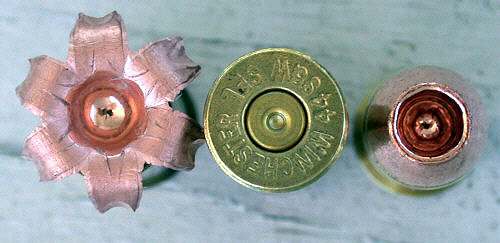
On the left we see an expanded .44 Special DPX bullet. In the center is a fired case. Notice that the primer has not flowed nor indicated high pressure. On the right is the unfired DPX from a felon's eye view.
Should you be interested in this ammunition or have further questions, you can go to Corbon's website at
www.corbon.com.I've been very impressed with Corbon's DPX line of ammo. It's pretty obvious that this company has been seeking to expand and improve their customer's ammunition choices. They still offer their original line of hyper-velocity JHP's as well as the more recent PowRball line of cartridges, but in .44 Special, DPX would be my first choice.
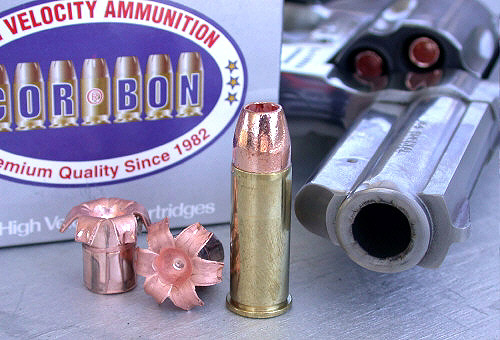
After 62 shots fired in today's tests, my revolver is not excessively fouled. It will be cleaned and then reloaded with Corbon 200-gr. DPX. From what I saw today, combined with reports from serious researchers elsewhere on DPX uniformity, it will be the defense load of choice for me in .44 Special.
The main "problem" I see with the DPX ammunition is cost. It is expensive. I asked Mr. Shovel why this ammunition was so expensive. Here is his reply:
"The whole DPX line is costly because the bullets cost so much. The 44 Spl bullet was made as a special production run for us. We are obligated to buy a certain amount from Barnes whether they sell or not, plus we had to put up the initial cost of the dies for Barnes since it was our request. Hopefully is they sell well, they cost will come down."
You can check the pricing at Corbon and decide if it's worth it to you or not. I made my decision. Unless something better comes along, I'm sticking with the DPX in .44 Special in medium to small guns as well as in some other calibers including 9mm and .357 Magnum.
Best.